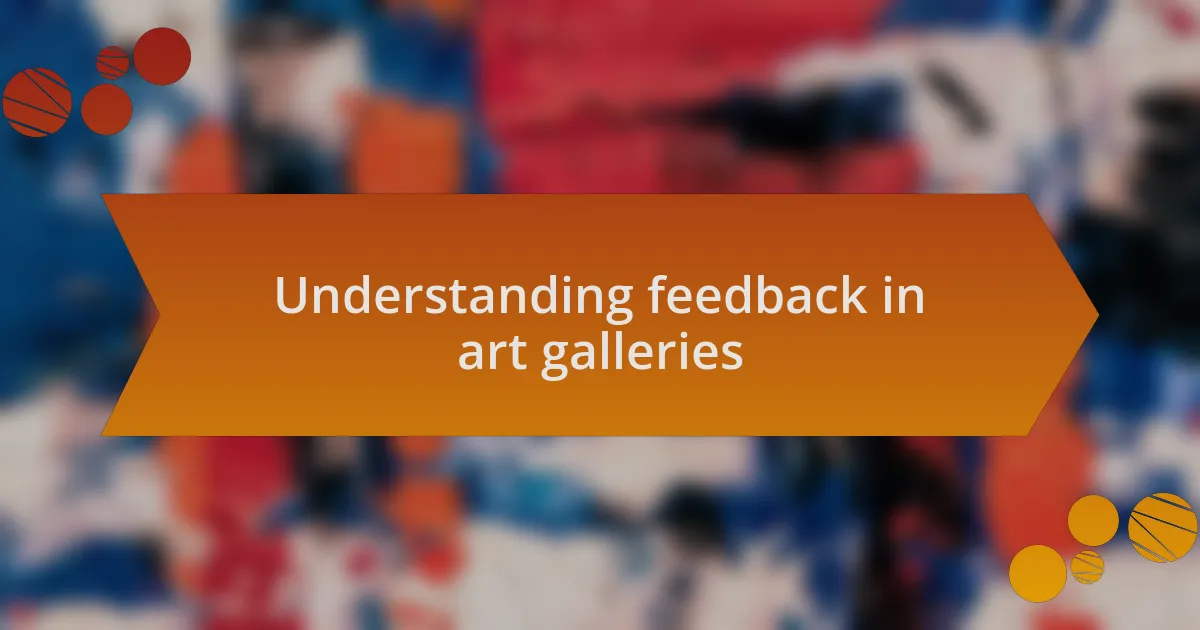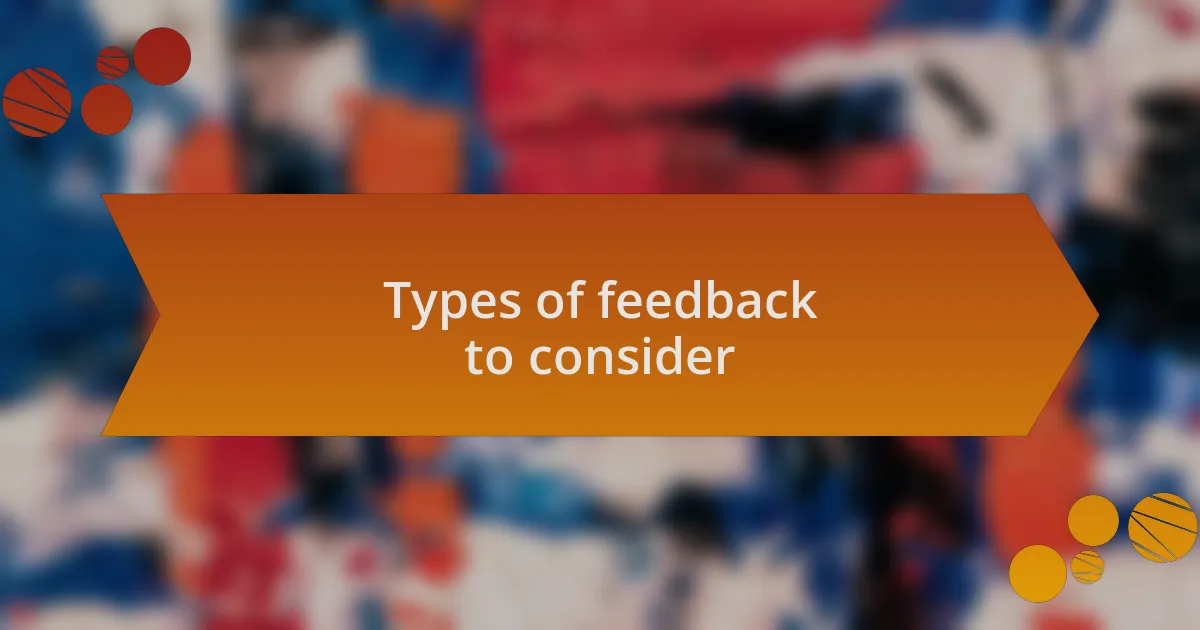Key takeaways:
- Feedback from audiences enhances artists’ understanding of their work, revealing emotional connections and diverse interpretations.
- Different types of feedback, such as emotional responses, constructive criticism, and casual observations, provide valuable insights for artistic growth.
- Implementing feedback effectively requires prioritizing actionable insights and fostering a transparent dialogue with visitors to strengthen community ties.
- Measuring the success of changes involves using qualitative and quantitative methods, including visitor engagement and social media responses, to evaluate the impact of adjustments.

Understanding feedback in art galleries
Feedback in art galleries is multifaceted, often serving as a mirror reflecting both the artwork’s impact and the audience’s emotional responses. I remember feeling a mix of excitement and apprehension during an exhibition where I received feedback on my own pieces. What would they think? This uncertainty, combined with curiosity, highlights how vital audience reactions are in shaping an artist’s journey and direction.
Understanding feedback in this context goes beyond mere opinions; it involves decoding the nuances of emotional reactions. When visitors express their thoughts, they reveal layers of interpretation that I might not see myself. Have you ever stood before a piece and felt an unexpected emotional surge? That’s the kind of insight I value the most – it’s raw, unfiltered, and deeply personal, providing essential clues about what resonates with the audience.
Importantly, feedback also creates a dialogue between the art and its viewers. For instance, I once had a conversation with a gallery attendee who saw something completely different in one of my paintings than I intended. That exchange not only enriched my understanding of the piece but also underscored how diverse perceptions can breathe new life into art. Isn’t it fascinating how each comment or critique can shape the artist’s vision and, in turn, influence future works?

Types of feedback to consider
When considering the types of feedback in an art gallery setting, I often think about emotional responses. I recall one occasion where a viewer shared how a particular piece reminded them of a pivotal moment in their life. It struck me that this kind of feedback is not just about art—it’s about connections and shared experiences. These heartfelt insights can guide my artistic direction more than any technical critique.
Another valuable type of feedback comes from constructive criticism, which focuses on technical aspects like composition, color use, and technique. Once, a mentor pointed out areas in one of my paintings that could benefit from balance and contrast. While it was tough to hear initially, that specific guidance helped me elevate my work significantly. How do you view constructive criticism? I’ve learned that embracing it can propel growth in ways that pure praise might not achieve.
Lastly, I pay close attention to casual observations, often made in passing. During an exhibit, a friend casually mentioned that they found a particular color choice unsettling. It made me pause and consider how subtle elements can provoke strong reactions. These offhand comments often reveal truths that others may hesitate to express, helping to broaden my understanding of how viewers perceive my art. Don’t you think those quieter voices can often provide just as much value as more formal feedback?

Techniques for gathering visitor feedback
Gathering visitor feedback can take many forms, and one method I find particularly effective is using simple comment cards. I often place these near the exit of the gallery, inviting visitors to share their thoughts on a specific piece or the overall experience. One time, a guest left a note that mentioned how the lighting enhanced their appreciation of certain artworks. It made me realize that sometimes, the physical environment can impact a visitor’s journey just as much as the artwork itself.
Another technique I frequently utilize is hosting informal discussion sessions after exhibitions. These gatherings create a space for visitors to voice their opinions and share their experiences over a cup of coffee. I still remember a session where a visitor shared how a specific installation made them reflect on their own life. Moments like these enrich my understanding and foster a sense of community around the gallery.
Digital feedback tools also play a crucial role in understanding what visitors think. Whether it’s a survey after an online exhibition or a poll on social media to gauge interest in future events, these platforms provide immediate and varied insights. I’ve used tools like Google Forms, and it amazes me how direct and honest people can be in a non-confrontational setting. Have you ever noticed how people feel freer to express their opinions when they aren’t face-to-face? This anonymity often unlocks deeper insights that might not surface in person.

Strategies for implementing feedback
Implementing feedback effectively requires a commitment to adapt based on what I learn. One of the tactics I find valuable is prioritizing actionable insights from feedback, rather than trying to address every comment. For instance, after reviewing several comments about our gallery layout, I decided to experiment with new signage to improve navigation. It was fascinating to see how these small changes enhanced the visitor experience, turning previously overlooked corners of the gallery into engaging spaces.
I also believe in fostering a culture of transparency around feedback. After a visitor suggested adding more interactive elements, I organized a brainstorming session with the team. Not only did this lead to creative ideas, but it also empowered my colleagues to feel invested in the gallery’s evolution. When I later shared the outcomes of that brainstorming session with the same visitor, their excited reaction reaffirmed the importance of involving others in the creative process.
Furthermore, consistency in following up on feedback can really strengthen the relationship with visitors. I make it a point to acknowledge input through our social media channels, offering updates on how we’ve implemented changes based on visitor suggestions. This dialogue not only keeps them engaged but also creates a sense of ownership in our community. Have you ever felt more connected to a place when your opinion was valued? That’s the atmosphere I’m aiming to cultivate in my gallery.

Personal experiences with feedback
When I first opened the gallery, I was hesitant about inviting feedback. That changed one day after a particularly candid visitor shared their thoughts about the lighting. Their honesty moved me; it wasn’t just criticism but a genuine desire to see the art in its best light. I took that to heart and changed the illumination, which completely transformed the ambiance. Have you ever made a minor adjustment that resulted in a major impact?
One memorable instance involved a local artist who attended an exhibit. She mentioned how certain pieces felt disconnected from the overall theme. Instead of brushing off her observation, I engaged her in a deeper conversation. I realized that feedback is an opportunity for dialogue, making me appreciate different perspectives. This experience taught me that each comment carries the potential to enrich our vision; have you considered how feedback can deepen your understanding of your work?
I remember a group of schoolchildren visiting the gallery, and their responses varied so much from adults. One child excitedly pointed out that a painting reminded him of his favorite video game. This moment reinforced how feedback comes in all forms and ages. I later decided to host workshops aimed at younger audiences, enriching our community ties and nurturing future art lovers. Reflecting on my experiences, I often wonder: how can we, as artists and curators, continuously learn from our audience?

Measuring success of changes made
To gauge the effectiveness of the changes I’ve implemented based on feedback, I rely on a mixture of qualitative and quantitative methods. For instance, after adjusting the gallery layout based on visitor suggestions, I noticed a noticeable increase in foot traffic and engagement. Have you ever tracked visitor interactions to see if your changes resonated with them?
In addition to visitor numbers, I also create informal surveys for guests, encouraging them to share their thoughts about specific adjustments. I distinctly remember a moment when an attendee, after seeing the new layout, exclaimed that it made the artwork more accessible. Those insights are often the most fulfilling, reinforcing that we’re not just exhibiting art; we’re creating experiences. What small changes have you made that ignited such enthusiasm from your audience?
Finally, I keep an eye on social media and online reviews, which provide instant feedback on the changes we’ve made. I vividly recall a particularly glowing review that praised our new thematic displays, highlighting how they sparked joy for visitors. Moments like that remind me how crucial it is to listen and adapt; it’s not just about art but about forging connections. How do you celebrate positive responses while also preparing for constructive criticism?